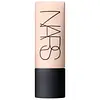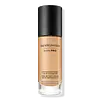NARS Cosmetics Soft Matte Complete Foundation Versus bareMinerals Barepro Performance Wear Liquid Foundation SPF 20
What's inside
What's inside
 Key Ingredients
Key Ingredients

 Benefits
Benefits

 Concerns
Concerns

 Ingredients Side-by-side
Ingredients Side-by-side

Water
Skin ConditioningDimethicone
EmollientMethyl Methacrylate Crosspolymer
Trimethylsiloxysilicate
EmollientGlycerin
HumectantLauryl PEG-9 Polydimethylsiloxyethyl Dimethicone
Skin ConditioningSodium Chloride
MaskingBis-Butyldimethicone Polyglyceryl-3
CleansingOryza Sativa Bran Extract
Skin ConditioningHelianthus Annuus Extract
EmollientRosmarinus Officinalis Leaf Extract
AntimicrobialPlankton Extract
Skin ConditioningAlteromonas Ferment Extract
Skin ConditioningPEG-12 Dimethicone
Skin ConditioningPEG-10 Dimethicone
Skin ConditioningButylene Glycol
HumectantAluminum Hydroxide
EmollientPolysilicone-2
Disteardimonium Hectorite
StabilisingCI 77120
Cosmetic ColorantTocopherol
AntioxidantHydrogen Dimethicone
Sodium Acetylated Hyaluronate
HumectantAlumina
AbrasiveGlucose
HumectantHydrolyzed Pea Protein
EmollientSodium Succinate
BufferingPhenoxyethanol
PreservativeIron Oxides
CI 77492
Cosmetic ColorantCI 77499
Cosmetic ColorantMica
Cosmetic ColorantCI 77891
Cosmetic ColorantWater, Dimethicone, Methyl Methacrylate Crosspolymer, Trimethylsiloxysilicate, Glycerin, Lauryl PEG-9 Polydimethylsiloxyethyl Dimethicone, Sodium Chloride, Bis-Butyldimethicone Polyglyceryl-3, Oryza Sativa Bran Extract, Helianthus Annuus Extract, Rosmarinus Officinalis Leaf Extract, Plankton Extract, Alteromonas Ferment Extract, PEG-12 Dimethicone, PEG-10 Dimethicone, Butylene Glycol, Aluminum Hydroxide, Polysilicone-2, Disteardimonium Hectorite, CI 77120, Tocopherol, Hydrogen Dimethicone, Sodium Acetylated Hyaluronate, Alumina, Glucose, Hydrolyzed Pea Protein, Sodium Succinate, Phenoxyethanol, Iron Oxides, CI 77492, CI 77499, Mica, CI 77891
Water
Skin ConditioningCyclopentasiloxane
EmollientTrimethylsiloxysilicate
EmollientButylene Glycol
HumectantSilica
AbrasivePEG-10 Dimethicone
Skin ConditioningBis-Butyldimethicone Polyglyceryl-3
CleansingBambusa Arundinacea Stem Extract
Skin ConditioningSodium Glutamate
MaskingDisteardimonium Hectorite
StabilisingSorbitan Sesquiisostearate
EmulsifyingHydrogenated Lecithin
EmulsifyingMethicone
EmollientPapain
Skin ConditioningAluminum Hydroxide
EmollientStearic Acid
Cleansing1,2-Hexanediol
Skin ConditioningCaprylyl Glycol
EmollientCarbomer
Emulsion StabilisingAlgin
MaskingTocopherol
AntioxidantSodium Dehydroacetate
PreservativePhenoxyethanol
PreservativeTitanium Dioxide
Cosmetic ColorantIron Oxides
Water, Cyclopentasiloxane, Trimethylsiloxysilicate, Butylene Glycol, Silica, PEG-10 Dimethicone, Bis-Butyldimethicone Polyglyceryl-3, Bambusa Arundinacea Stem Extract, Sodium Glutamate, Disteardimonium Hectorite, Sorbitan Sesquiisostearate, Hydrogenated Lecithin, Methicone, Papain, Aluminum Hydroxide, Stearic Acid, 1,2-Hexanediol, Caprylyl Glycol, Carbomer, Algin, Tocopherol, Sodium Dehydroacetate, Phenoxyethanol, Titanium Dioxide, Iron Oxides
 Reviews
Reviews

Ingredients Explained
These ingredients are found in both products.
Ingredients higher up in an ingredient list are typically present in a larger amount.
Aluminum Hydroxide is a form of aluminum. It can be naturally found in nature as the mineral gibbsite. In cosmetics, Aluminum Hydroxide is used as a colorant, pH adjuster, and absorbent.
As a colorant, Aluminum Hydroxide may add opacity, or reduce the transparency. Aluminum hydroxide is contains both basic and acidic properties.
According to manufacturers, this ingredient is an emollient and humectant. This means it helps hydrate the skin.
In medicine, this ingredient is used to help relieve heartburn and help heal ulcers.
There is currently no credible scientific evidence linking aluminum hydroxide in cosmetics to increased cancer risk.
Major health organizations allow the use of aluminum hydroxide in personal care products and have not flagged it as a carcinogenic risk at typical usage levels.
Learn more about Aluminum HydroxideBis-Butyldimethicone Polyglyceryl-3 is a type of silicone.
Butylene Glycol (or BG) is used within cosmetic products for a few different reasons:
Overall, Butylene Glycol is a safe and well-rounded ingredient that works well with other ingredients.
Though this ingredient works well with most skin types, some people with sensitive skin may experience a reaction such as allergic rashes, closed comedones, or itchiness.
Learn more about Butylene GlycolDisteardimonium Hectorite comes from the clay mineral named hectorite. It is used to add thickness to a product.
It can also help stabilize a product by helping to disperse other ingredients.
Hectorite is a rare, white clay mineral.
Learn more about Disteardimonium HectoritePeg-10 Dimethicone is silicone with conditioner and emulsifier properties. It mostly acts as an emollient in skincare and and humectant in haircare.
According to the manufacturer, acidic formulations decrease the stability of this ingredient. It works best in neutral or near neutral formulations.
Phenoxyethanol is a preservative that has germicide, antimicrobial, and aromatic properties. Studies show that phenoxyethanol can prevent microbial growth. By itself, it has a scent that is similar to that of a rose.
It's often used in formulations along with Caprylyl Glycol to preserve the shelf life of products.
Tocopherol (also known as Vitamin E) is a common antioxidant used to help protect the skin from free-radicals and strengthen the skin barrier. It's also fat soluble - this means our skin is great at absorbing it.
Vitamin E also helps keep your natural skin lipids healthy. Your lipid skin barrier naturally consists of lipids, ceramides, and fatty acids. Vitamin E offers extra protection for your skin’s lipid barrier, keeping your skin healthy and nourished.
Another benefit is a bit of UV protection. Vitamin E helps reduce the damage caused by UVB rays. (It should not replace your sunscreen). Combining it with Vitamin C can decrease sunburned cells and hyperpigmentation after UV exposure.
You might have noticed Vitamin E + C often paired together. This is because it is great at stabilizing Vitamin C. Using the two together helps increase the effectiveness of both ingredients.
There are often claims that Vitamin E can reduce/prevent scarring, but these claims haven't been confirmed by scientific research.
Learn more about TocopherolThis silicone is an emollient. Emollients create a thin film on the skin to prevent moisture from escaping.
It is not soluble in water and helps increase water-resistance in products.
According to a manufacturer, it can blend seamlessly with silicone oils, such as Cyclopentasiloxane.
Learn more about TrimethylsiloxysilicateWater. It's the most common cosmetic ingredient of all. You'll usually see it at the top of ingredient lists, meaning that it makes up the largest part of the product.
So why is it so popular? Water most often acts as a solvent - this means that it helps dissolve other ingredients into the formulation.
You'll also recognize water as that liquid we all need to stay alive. If you see this, drink a glass of water. Stay hydrated!
Learn more about WaterThis ingredient is a combination of red, black, and yellow iron oxide pigments. This combination of colors is usually found in foundation, because it results in a "skin" color.